 While heat is generally the enemy of power system transmission lines, strong winter weather brings a new set of challenges for utilities, which is why it’s important for them to take the necessary actions to fight winter power outages.
While heat is generally the enemy of power system transmission lines, strong winter weather brings a new set of challenges for utilities, which is why it’s important for them to take the necessary actions to fight winter power outages.
Ice and snow can quickly cause widespread outages from damaged utility poles and power lines. A ¼ inch of ice accumulation on power lines can add up to 250 pounds of weight, and accumulations of up to 1 inch of ice can cause serious damage to trees and power lines.
With winter conditions, ice may linger well after an initial storm. It’s important to know the realities around winter storms and their effect on substation and transmission components. Here are a few things to be aware of:
- Generally, transmission lines in the southern states are not built to handle ice.
- If trees become loaded with ice, they’re at risk of falling across a transmission line.
- Power switches can struggle in ice conditions. As ice collects, the switches can become frozen while closed or open. Power switches do have some ice breaking ability, but there is a limit. They can quickly be rendered inoperable with a heavy ice coating. This reduces the ability of a power company to make power flow changes, which can compensate for sudden changes in load or generation.
- Winter storms can heavily affect insulators. In the case of ice buildup due to moisture and quick freezing, the impact will result from the ice sticking and allowing mass to congregate on the insulator and the line. In this situation, a failure will most likely occur with the hardware or the line itself, as opposed to the insulator.
Remember: when working to shorten or prevent winter power outages, close storm monitoring and visual inspections are key.
How do you fight winter power outages? It’s all about system frequency observation
Operators monitoring winter conditions should closely manage the frequency (or speed) of the power system. The speed must be tightly controlled with the max and min both at 60 Hz. Other points to consider regarding system load observation:
- Cold temperatures or strong winds may cause some line failures, which will decrease system loading. This will potentially leave too much generation on the system and the frequency will increase above 60 Hz.
- Likewise, if a generator is removed from service (i.e., the transmission line going from the generator step-up substation) and is compromised by ice loading, the system frequency can trend below 60 Hz.
- Operators at a power system can adjust the generator output to mitigate the load loss, which works to keep the frequency close to normal.
This article was drafted in partnership with Hubbell Power Systems. Read the original article, “Winter tips for handling substation and transmission components.”
Related posts
Winter shift scheduling tools for safety supervisors (FREE DOWNLOAD)
Thermal winter work gloves provide quality insulation in extreme cold